Click on images to enlarge

habit (Photo: Sheldon Navie)
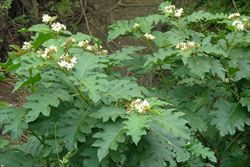
habit in flower (Photo: Sheldon Navie)

older woody stem with spines (Photo: Sheldon Navie)
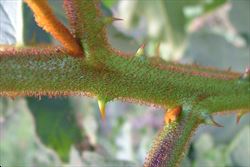
close-up of reddish hairs and spines on young growth (Photo: Sheldon Navie)
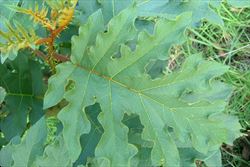
very large deeply-lobed leaf (Photo: Sheldon Navie)
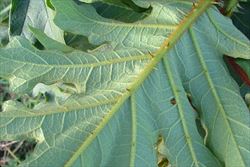
close-up of leaf underside (Photo: Sheldon Navie)

dense flower cluster (Photo: Sheldon Navie)
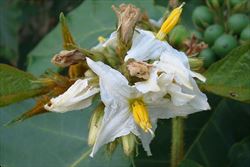
close-up of flowers (Photo: Sheldon Navie)

large cluster of immature fruit (Photo: Sheldon Navie)
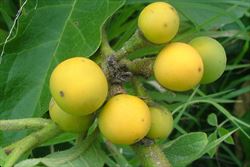
close-up of mature fruit (Photo: Sheldon Navie)
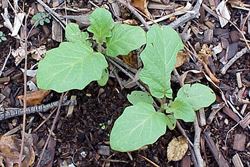
seedlings (Photo: Sheldon Navie)
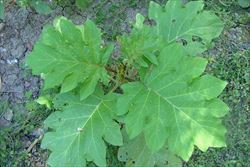
young plant (Photo: Sheldon Navie)
Scientific Name
Solanum chrysotrichum Schltdl.
Synonyms
Solanum hispidum Pers. (misapplied)
Family
Solanaceae
Common Names
devil's fig, giant devil's fig
Origin
Native to Mexico and Central America (i.e. Costa Rica, Guatemala, Nicaragua and Panama).
Naturalised Distribution
A relatively naturalised species that is mainly found in the coastal districts of eastern Australia (i.e. in south-eastern Queensland and the coastal districts of northern and central New South Wales). It is also sparingly naturalised in Victoria.
Also naturalised overseas in Africa.
Habitat
A weed of watercourses (i.e. riparian areas), closed forests, forest margins, roadsides, parks, gardens, disturbed sites and waste areas.
Habit
An upright (i.e. erect) shrub or small tree usually growing 1.5-4 m tall.
Distinguishing Features
- an upright and spreading shrub or small tree with prickly stems and leaves.
- its younger stems and leaves are densely covered in star-shaped hairs.
- its very large leaves (9-35 cm long and 5.5-30 cm wide) are usually deeply lobed.
- its white star-shaped flowers (3-4.5 cm across) are borne in large branched clusters.
- its globular fruit (10-15 mm across) turn yellow as they mature.
Stems and Leaves
The younger stems and leaf stalks (i.e. petioles) are greenish and densely covered with star-shaped (i.e. stellate) hairs which are often reddish on new growth. They are also sparsely covered in green prickles 2-6 mm long. Older stems are greyish in colour and covered in larger thorns (3-9 mm long and to 5 mm wide at the base).
The large leaves (9-40 cm long and 5.5-30 cm wide) are alternately arranged along the stems and borne on stalks (i.e. petioles) 1.5-6 cm long. They are broad with several (7-13 lobes) shallow to deep lobes that cut between a quarter and half-way to the middle of the leaf (i.e. midrib). These lobes may be either pointed or rounded (i.e. acute or obtuse). Their undersides are densely covered in star-shaped (i.e. stellate) hairs and their mid-veins may sometimes have some small prickles (2-6 mm long). Prickles are absent from the upper surfaces of adult leaves, but they may be present on the leaves of younger plants.
Flowers and Fruit
The white flowers (3-4.5 cm across) are arranged in branched clusters (i.e. corymbs or panicles), each containing up to fifty or more flowers. These flowers are star-shaped (i.e. stellate) and borne on stalks (i.e. pedicels) 3-15 mm long. Each flower has five green sepals (7-10 mm long) that are densely hairy and five white petals (14-20 mm long) that are fused together at the base. They also have five stamens with yellow anthers (6-9 mm long) and an ovary topped with a style (10-13 mm long) and stigma. Flowering occurs from autumn through to spring.
The globular fruit (1-1.7 cm across) turn from green to yellowish-green, yellow or yellowish-orange as they mature. They contain numerous pale yellow seeds (2.4-2.8 mm long).
Reproduction and Dispersal
This species reproduces mainly by seed, which are most commonly dispersed by birds and other animals that eat the mature fruit. They may also be spread by water and in mud or contaminated soil.
Environmental Impact
Giant devil's fig (Solanum chrysotrichum) is regarded as an environmental weed in Queensland and New South Wales.
Other Impacts
Giant devil's fig (Solanum chrysotrichum) is suspected of poisoning livestock and its sharp prickles can inflict injuries on animals and people.
Legislation
Not declared or considered noxious by any state government authorities.
Management
The Brisbane City Council has published a management procedure for dealing with Solanum chrysotrichum which appears to suggest two methods. For large plants, the plant is felled and a herbicidal spray is applied to the cut stump surface to kill the stump and root system. For smaller plants, a foliar application of the herbicide is sufficient.
Similar Species
Giant devil's fig (Solanum chrysotrichum) is very similar to devil's fig (Solanum torvum). These two sepcies can be distinguished by the following differences:
- giant devil's fig (Solanum chrysotrichum) has moderately large to very large leaves (usually 9-35 cm long) with several to numerous (seven to thirteen) moderately deep to very deep lobes. Its relatively large white flowers (30-40 mm across) have relatively large sepals (7-10 mm long). The dense star-shaped (i.e. stellate) hairs on its new growth are reddish in colour.
- devil's fig (Solanum torvum) has moderately large leaves (usually 5-21 cm long) with several (about seven) slight to moderately deep lobes. Its relatively small white flowers (up to 25 mm across) have small sepals (3-4 mm long). The dense star-shaped (i.e. stellate) hairs on its new growth are whitish or yellowish in colour.
Note: For a more in-depth key to distinguish between all of the solanums (Solanum spp.) present in eastern Australia, see the online key to the Solanum Species of Eastern Australia at http://delta-intkey.com/solanum/index.htm.
This fact sheet has been updated thanks to the sponsorship of Sunshine Coast Council.

